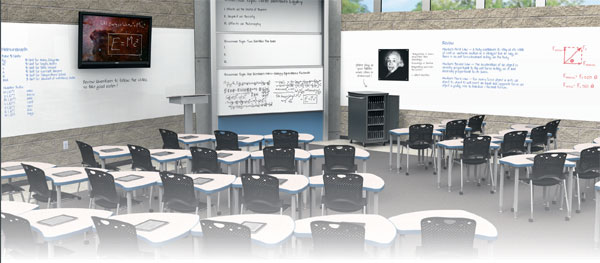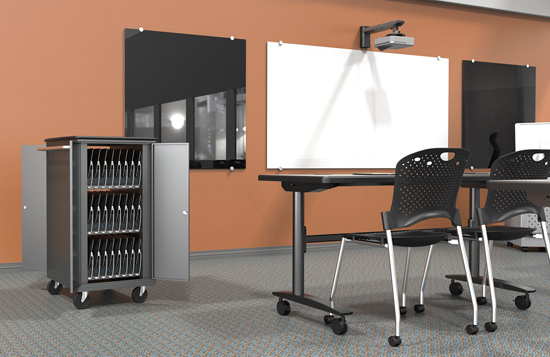Designing Schools for a Modern Learning Environment
Driven partly by technology and mirroring the open concept layout of today’s innovative corporate campuses, intelligently designed classrooms for high-impact learning will better equip students for their collaborative future workplaces, and for solving the world’s complex problems. This course will educate architects, designers and others about what makes up forward-thinking schools and classrooms and how to design, specify for and furnish them.
Why and How Schools Are Changing to Active Learning Environments

Image courtesy of MooreCo Inc.
Even when seats are arranged in a somewhat traditional lecture format, the teaching surfaces and technology the instructor uses to convey lessons is highly advanced from just a few years ago.
There are many reasons to change our education systems. Preparing today’s students for the future presents new challenges, based on such factors as globalization, technology, migration, international competition and changing markets.
This is according to a Rand Corporation research report commissioned by the Asia Society on new ways of learning. Dr. Darlene Opfer, director of Rand Education, said in a talk called “Lessons from the Science of Learning for 21st-Century Schools”ii there are three main reasons we need to change the way we teach:
1. We need a workforce with better thinking and collaborative skills.
2. Our students need to learn how to have civic involvement.
3. We now live in a globally connected world.
“What does this look like? What does this mean in terms of the way we should be teaching?” Opfer asked.
Some suggestions from Opfer’s talk on “Lessons from the Science of Learning for 21st-Century Schools” include:
• Promote teamwork as both a process and an outcome—show students how to work in teams toward a common goal.
• Exploit technology to support learning—incorporating technology into the classroom better prepares students for the working world.
• Foster student creativity—the problems of the world demand creative thought, not just “book knowledge,” but new approaches.
• Make it relevant—identify the key ideas, the key concepts, rather than the specifics. David Perkins, one of the key scholars in learning research, talks about it like a baseball team. If you want to understand how baseball works, you need to understand the key topics of baseball: hitting, catching, throwing, running. With math, for instance, what are the key ideas and how do they fit together?
• Teach through the disciplines—instead of asking: “Can you memorize all the presidents of the United States?” the idea is to understand how the presidents operated, to understand why something is important. Andrew Parker, a Rand researcher in the Pittsburgh office, did a study to demonstrate this idea. In cooperation with a school district in Portland, he worked with history teachers to see if they could help students become better decision makers. Half the teachers taught the way they always teach, with memorization and lectures. The other half taught around key decisions in American history, asking students: Why was this decision made? What are the options that could have been considered? Could they have made another decision? Afterward, the students taught in the new way demonstrated better decision-making skills and the equivalent of six months more of history education.
• Simultaneously develop higher and lower thinking skills—students should be taught how to analyze and think, as well as how to memorize.
• Encourage transfer of learning—this is teaching students how to transfer skills learned in school to a job, or skills learned in one job to the next job.
• Teach students how to learn—when students learn to learn, that sets them up to be lifelong learners, rather than passive recipients of information.
• Address misunderstandings directly—most of us have misunderstandings about how the world works. Until we learn otherwise, many of us think the earth is flat. By active engagement, with our own experience, we unravel our misunderstandings and learn the truth.
For inspiration on new teaching environments for emerging methods of teaching, we could look to the corporate world, especially in technology companies, which have evolved to flexible spaces to foster creativity, teamwork and transfer of knowledge. Indeed, these are the workspaces in which some of today’s students will likely end up.
Likewise, classroom designers can also learn from the downside of a totally open workspace and the solutions that have emerged. An article in Forbesiii presented solutions to an open office where individual concentration can be difficult when it’s needed. The dilemma is how to provide areas for focus without a retreat to isolating offices or constricting cubicles. One solution: small quiet areas within the open environment for times of quiet focus.
In classrooms, this blend of openness and focus translates into banks of computer stations along the walls, with flexible furniture and displays within the room.
How Classrooms Are Evolving for Better Learning Environments

Image courtesy of MooreCo Inc.
This classroom charging station for tablets exemplifies how technology is changing the environment for learning, teaching, and classroom set-up. It’s conceivable that students will no longer need large backpacks to carry heavy textbooks, but may primarily access their books and multimedia learning materials from their tablets.
When classrooms are stiff and boring, students do not learn. That is the assessment of research by the Canadian Center of Science.
“More often than not, learning environments are uninteresting and uninviting,” states a report titled Quality Learning Environments: Design-Studio Classroom.iv
However, research suggests that an intelligent, thoughtful interior design improves both the functionality of a learning environment and also increases the confidence of teachers and learners.
The report continues: “The interior design of spaces such as offices, dining halls, libraries, auditoriums and classrooms should satisfy the minimum requirements of making these spaces more functional, healthier and more enjoyable.”
The lack of proper design actually causes harm, the report states. “Students and instructors suffer from interior problems of classrooms such as inadequate lighting, noise, glare, poor air quality, inappropriate temperature, uncomfortable seats and inflexible seating arrangement.”
According to the report, “The classroom is the most important area in a school. It is an environment that includes various aspects such as psychological, cultural, social and physical. It is where students and teachers spend a large amount of their time and, hence, it is an environment that is assumed to promote a reasonable level of concentration in learning activities such as discussing, reading, drafting, drawing, writing and practicing. Designers ought to pay enough attention to environmental aspects when designing classroom environments. They should create a human-centered environment that supports teaching/learning processes and enhances students’ and instructors’ performance.”
Also offering research on the importance of the classroom environment is the Advanced Learning Technologies (ALTEC) project at the University of Kansas Center for Research on Learning.
“The size of the classroom and interior areas, the colors of the walls, the type of furniture and flooring, the amount of light, and the room arrangement all influence how students learn,” the project emphasizes. “Thoughtful arrangement of the indoor and outdoor environments will support learning goals for students.” Indeed, ALTEC offers an online tool, dubbed “Classroom Architect,” for teachers to experiment with the layout of classrooms.v
According to an article by James Seaman, AIA, LEED AP, an associate with TMP Architecture, “Considering multiple learning-style profiles, an agile learning environment provides flexibility, adaptability and a variety of learning environments on demand. In other words, yesterday’s typical 30-by-30 classroom for 30 students and one teacher doesn’t cut it anymore.”
“Teachers today must be able to vary their instruction in response to a student’s individual learning preferences,” Seaman continues. “Differentiated instruction expert and author Carol Ann Tomlinson states that teachers generally have the ability to adjust and adapt four factors: content, process, product and the learning environment itself for creating the best learning experience. If the classroom design is not agile, the space cannot adapt to an individual effortlessly and expediently. Moveable components should be emphasized.”vi
According to ALTEC, “There is no one way to arrange a classroom. Room arrangement will differ according to the ages and previous experiences of the students, the background knowledge of the teachers and their willingness to experiment with new ideas. The goal is to create an environment for students that will nurture their explorations, language and ideas. In planning their room environment, teachers should act on what they know about children and their development.”
As ALTEC further states, “The types of materials in a classroom and the way in which they are organized convey important messages to students. A room that is attractive, cheerful, orderly and filled with interesting objects conveys the message: ‘This is a comfortable place where you can explore, feel safe and learn.’ Teachers who are aware of the power of the environment are able to arrange indoor and outdoor spaces to convey the messages they want students to receive.”
ALTEC suggests that environments that promote learning include various types of spaces for groups, such as rugs and tables, that:
• Provide space for work.
• Promote student-to-student interaction in small groups.
• The spaces of the classroom may be used flexibly to allow additional staff members to work with students as needed.
• Create small, well-defined, student-friendly/cozy spaces that encourage interactions.
These small, well-defined spaces will assist with learning that:
• Is more creative and encourages behaviors that are productive.
• Highlights individual concepts such as science or writing.
• Incorporates language and literacy development within each space.
The domino effect on behavior, ALTEC says, will demonstrate more cooperation between students, more on-task behavior and fewer behavioral problems.









